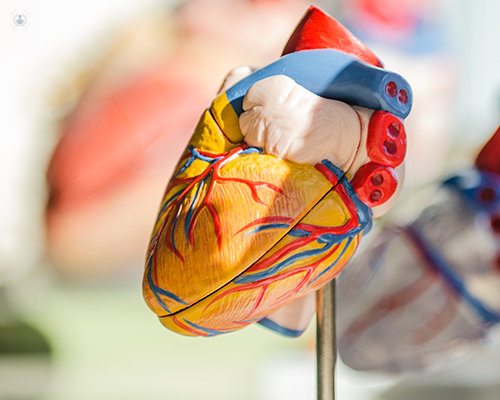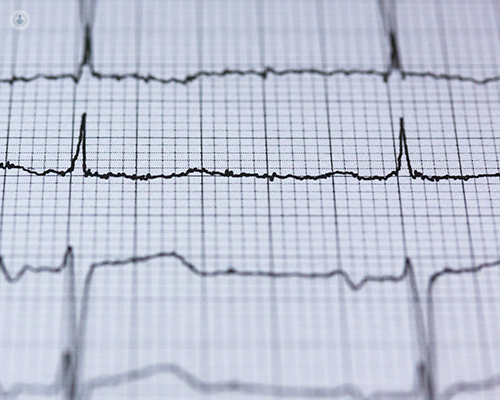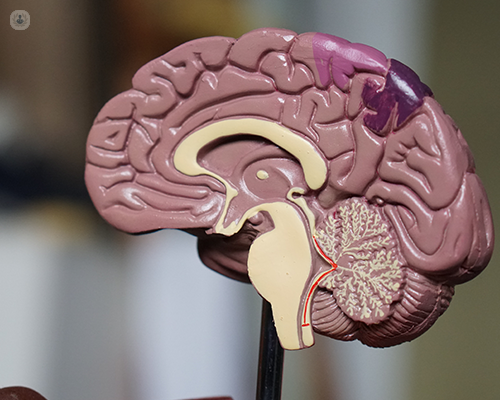Support atrial fibrillation treatment with lifestyle habits
Escrito por:Do you know which lifestyle adjustments help in the treatment of atrial fibrillation (AF) and how? Learn from a leading UK cardiologist and electrophysiologist, Dr Saagar Mahida, about how your medical treatment for atrial fibrillation can be supported by a combination of lifestyle habits.

Firstly, what is atrial fibrillation?
Atrial fibrillation (AF) is a heart rhythm abnormality (also referred to as an arrhythmia). In this condition, the normal organised and regular heart rhythm is replaced by an irregular and often chaotic heart rhythm. Atrial fibrillation is the most common heart rhythm abnormality leads to referral to a doctor.
What are the symptoms?
Patients with AF might experience various symptoms including heart palpitations (when the heart beats fast with an irregular pattern), fatigue, dizziness and a reduced ability to exercise.

The pattern of atrial fibrillation can be characterised by brief intermittent episodes of abnormal heart rhythm (clinically called paroxysmal atrial fibrillation) or continuous atrial fibrillation (also known as persistent atrial fibrillation).
How is it treated?
Treatment for AF includes curative procedures (procedures intended to eliminate all symptoms) called catheter ablation procedures, as well as medications. It also involves lifestyle modifications, which also play an important role in treating atrial fibrillation. In recent years, there has been an increasing focus on more holistic approaches for treating AF that aim to use lifestyle modifications to complement a curative catheter ablation and/or medications.
What are the risk factors?
The risk factors for developing atrial fibrillation can be divided into two groups: those that can be modified by the patient and those that cannot be modified.
Risk factors that the patient can modify:
- Obesity
- Physical inactivity/poor cardiorespiratory fitness
- High blood pressure (hypertension)
- Diabetes
- Alcohol consumption
- Smoking
- Sleep disorders that affect breathing
Risk factors that the patient cannot modify:
- Age
- Gender
- Ethnic background
- Genetic susceptibility
Lifestyle changes that target the modifiable risk factors can reduce the risk of developing AF. Changes can also reduce the progression of the disease and its symptoms in patients who already have a diagnosis of atrial fibrillation. Importantly, a number of lifestyle modifications for AF also have a positive impact on heart health and reduce the risk of other heart diseases.
The focus of this article is on lifestyle modifications in patients with atrial fibrillation.
Exercise
The level of exercise has been shown to influence the risk of developing atrial fibrillation. However, the relationship between exercise and atrial fibrillation is not simple.

Low levels of exercise and poor cardiorespiratory fitness levels are associated with a higher risk of developing AF.1,2 On the other hand, high-intensity endurance training might also increase the risk of AF. 3 Therefore, the right ‘dose’ of exercise may be important in minimizing the risk of developing atrial fibrillation.
Amongst patients who already have a diagnosis of atrial fibrillation, exercise is a particularly important consideration. While it’s common for patients with atrial fibrillation to feel nervous about exercise, the appropriate level of exercise is predicted to have a positive impact on AF and heart health in general. The optimal exercise programmes for patients with atrial fibrillation have not been fully defined but there is evidence to suggest that aerobic interval training improves symptoms, exercise capacity and quality of life in AF patients.4
Dietary habits
A healthy diet has a positive impact on atrial fibrillation and heart health in general. In addition to promoting weight loss, a healthy diet reduces the risk of developing diabetes and high blood pressure and it promotes better control of those in people who already have these conditions.

Obesity, diabetes and high blood pressure are associated with an increased risk of developing atrial fibrillation and it can result in poorer outcomes in patients who already have a diagnosis of atrial fibrillation.
The question of the optimal diet in patients with atrial fibrillation is not fully answered. A number of previous studies have demonstrated that the Mediterranean diet, which typically contains fish and plant-based foods, may reduce the risk of atrial fibrillation.5 It has been proposed that the presence of natural antioxidants in foods such as olive oil, nuts and fruits and vegetables may reduce atrial fibrillation.6-8 There is some recent evidence to suggest that a low carbohydrate diet may be associated with an increased risk of developing atrial fibrillation, regardless of the type of protein or fat used to replace carbohydrates.9 But overall, before specific diets can be recommended in patients with atrial fibrillation, more research studies are necessary. As discussed above, the biggest impact of a healthy diet is likely to be related to weight loss and modification of risk factors for atrial fibrillation such as diabetes and high blood pressure.
Optimisation of weight
Overweight and obese patients have a significantly higher risk of developing atrial fibrillation .10

Also, overweight patients may also progress faster from brief and sporadic episodes of abnormal heartbeats to continuous episodes and therefore, have worse symptoms.11,12 What's more, overweight patients have a higher risk of the catheter ablation procedure failing.13
Weight loss has the potential to reduce symptoms and positively influences other risk factors of atrial fibrillation such as as high blood pressure and diabetes and promotes heart health in general.14 Patients who lose weight have been proven to have a significantly higher chance of their catheter ablation procedure being successful.15 Importantly, even relatively small amounts of weight loss could reduce atrial fibrillation episodes.
Alcohol
The association between excessive alcohol and atrial fibrillation is well recognised. The phrase ‘holiday heart syndrome’ is commonly used to describe atrial fibrillation from binge drinking.


Moderate levels of alcohol consumption in people who regularly drink could also increase the risk of developing atrial fibrillation. Essentially, as the ‘dose’ of alcohol increases, so does the risk of atrial fibrillation. Not surprisingly, people who are already diagnosed with AF that increase their alcohol intake can trigger persistent episodes of atrial fibrillation and have a higher load of symptoms. Increased alcohol intake is also associated with faster progression from transient intermittent (paroxysmal) atrial fibrillation to continuous (persistent) atrial fibrillation) 16 and it’s also associated with a higher failure rate after catheter ablation procedures.17
Aside from triggering episodes of AF and increasing symptoms, alcohol can increase blood pressure and weight. It could be associated with an increased risk of and sleep apnoea (sleep-disordered breathing), which in turn also influences the risk of atrial fibrillation.
Caffeine and other stimulants
The link between drinking coffee and stimulant drinks with AF is not clearly defined.

Research studies on caffeine and atrial fibrillation have reported inconsistent results and the overall effect of caffeine is not well understood.18 While there are some reports of patients developing atrial fibrillation episodes after consuming stimulant drinks, once again, there is not enough research evidence on the subject.
Overall, avoidance of caffeine and stimulants would be recommended in patients in whom these drinks are known to trigger atrial fibrillation episodes. But there is not enough evidence to recommend avoidance of these drinks in all atrial fibrillation patients.
Management of stress
There is relatively limited information on whether anxiety/stress is a trigger for AF but several previous research studies have reported a potential mutual relationship between AF and anxiety.

It is often difficult to determine whether anxiety is a cause or a consequence of atrial fibrillation or if psychological stress is a potential trigger for atrial fibrillation.
Previous studies have reported an association between negative emotion and atrial fibrillation. The higher the number of ‘happy days’, the lower the burden of atrial fibrillation .19 Activities that have been associated with lower stress levels (such as yoga) have been linked to a reduced number of symptomatic atrial fibrillation episodes.20 There is also some evidence indicating that patients with higher levels of anxiety have more recurrences of atrial fibrillation after ablation procedures.21
Patient-specific lifestyle changes
The discussion above has focused on general lifestyle modifications for atrial fibrillation patients. However, a ‘one size fits all’ approach is often not effective when treating patients with atrial fibrillation. Individual patients may benefit from tailoring their lifestyle changes based on their specific risk profile and triggers for atrial fibrillation. For instance, for some patients, removal of alcohol altogether may not be necessary but rather, defining the threshold that results in arrhythmia suppression might be more effective. By doing so, they can balance quality of life with atrial fibrillation control. For other patients, specific alternative triggers may be identified and lifestyle modifications put into place to avoid these triggers.
Conclusions
It is important to emphasize that the lifestyle measures discussed in this article are aimed as complementary measures to curative catheter ablation procedures and/or medical therapy. An integrated and holistic approach to the management of atrial fibrillation is likely to have a more positive long-term outcome in terms of management of AF. In isolation, lifestyle measures are likely to be only moderately effective in suppressing the arrhythmia. The lifestyle modifications discussed here are closely interrelated and modification of one aspect is likely to have a positive impact on multiple different risk factors. However, these measures require a sustained and dedicated long-term strategy. The overall aim is to balance the reduction of arrhythmia burden and improve quality of life.
Click here to see Dr Mahida’s profile and discover how he can help you look after your health
References
1. Qureshi WT, Alirhayim Z, Blaha MJ, et al. Cardiorespiratory Fitness and Risk of Incident Atrial Fibrillation: Results From the Henry Ford Exercise Testing (FIT) Project. Circulation. 2015;131(21):1827-1834.
2. Huxley RR, Misialek JR, Agarwal SK, et al. Physical activity, obesity, weight change, and risk of atrial fibrillation: the Atherosclerosis Risk in Communities study. Circ Arrhythm Electrophysiol. 2014;7(4):620-625.
3. Calvo N, Ramos P, Montserrat S, et al. Emerging risk factors and the dose-response relationship between physical activity and lone atrial fibrillation: a prospective case-control study. Europace. 2016;18(1):57-63.
4. Malmo V, Nes BM, Amundsen BH, et al. Aerobic Interval Training Reduces the Burden of Atrial Fibrillation in the Short Term: A Randomized Trial. Circulation. 2016;133(5):466-473.
5. Geisler BP. Cardiovascular Benefits of the Mediterranean Diet Are Driven by Stroke Reduction and Possibly by Decreased Atrial Fibrillation Incidence. Am J Med. 2016;129(1):e11.
6. Martinez-Gonzalez MA, Toledo E, Aros F, et al. Extravirgin olive oil consumption reduces risk of atrial fibrillation: the PREDIMED (Prevencion con Dieta Mediterranea) trial. Circulation. 2014;130(1):18-26.
7. Mattioli AV, Miloro C, Pennella S, Pedrazzi P, Farinetti A. Adherence to Mediterranean diet and intake of antioxidants influence spontaneous conversion of atrial fibrillation. Nutr Metab Cardiovasc Dis. 2013;23(2):115-121.
8. Rix TA, Joensen AM, Riahi S, et al. A U-shaped association between consumption of marine n-3 fatty acids and development of atrial fibrillation/atrial flutter-a Danish cohort study. Europace. 2014;16(11):1554-1561.
9. Zhang S, Zhuang X, Lin X, et al. Low-Carbohydrate Diets and Risk of Incident Atrial Fibrillation: A Prospective Cohort Study. J Am Heart Assoc. 2019;8(9):e011955.
10. Wang TJ, Parise H, Levy D, et al. Obesity and the risk of new-onset atrial fibrillation. JAMA. 2004;292(20):2471-2477.
11. Tsang TS, Barnes ME, Miyasaka Y, et al. Obesity as a risk factor for the progression of paroxysmal to permanent atrial fibrillation: a longitudinal cohort study of 21 years. Eur Heart J. 2008;29(18):2227-2233.
12. Sandhu RK, Conen D, Tedrow UB, et al. Predisposing factors associated with development of persistent compared with paroxysmal atrial fibrillation. J Am Heart Assoc. 2014;3(3):e000916.
13. Wong CX, Sullivan T, Sun MT, et al. Obesity and the Risk of Incident, Post-Operative, and Post-Ablation Atrial Fibrillation: A Meta-Analysis of 626,603 Individuals in 51 Studies. JACC Clin Electrophysiol. 2015;1(3):139-152.
14. Abed HS, Wittert GA, Leong DP, et al. Effect of weight reduction and cardiometabolic risk factor management on symptom burden and severity in patients with atrial fibrillation: a randomized clinical trial. JAMA. 2013;310(19):2050-2060.
15. Pathak RK, Middeldorp ME, Meredith M, et al. Long-Term Effect of Goal-Directed Weight Management in an Atrial Fibrillation Cohort: A Long-Term Follow-Up Study (LEGACY). J Am Coll Cardiol. 2015;65(20):2159-2169.
16. Ruigomez A, Johansson S, Wallander MA, Garcia Rodriguez LA. Predictors and prognosis of paroxysmal atrial fibrillation in general practice in the UK. BMC Cardiovasc Disord. 2005;5:20.
17. Qiao Y, Shi R, Hou B, et al. Impact of Alcohol Consumption on Substrate Remodeling and Ablation Outcome of Paroxysmal Atrial Fibrillation. J Am Heart Assoc. 2015;4(11).
18. Bodar V, Chen J, Gaziano JM, Albert C, Djousse L. Coffee Consumption and Risk of Atrial Fibrillation in the Physicians' Health Study. J Am Heart Assoc. 2019;8(15):e011346.
19. Lampert R, Jamner L, Burg M, et al. Triggering of symptomatic atrial fibrillation by negative emotion. J Am Coll Cardiol. 2014;64(14):1533-1534.
20. Lakkireddy D, Atkins D, Pillarisetti J, et al. Effect of yoga on arrhythmia burden, anxiety, depression, and quality of life in paroxysmal atrial fibrillation: the YOGA My Heart Study. J Am Coll Cardiol. 2013;61(11):1177-1182.
21. Yu S, Zhao Q, Wu P, et al. Effect of anxiety and depression on the recurrence of paroxysmal atrial fibrillation after circumferential pulmonary vein ablation. J Cardiovasc Electrophysiol. 2012;23 Suppl 1:S17-23.


